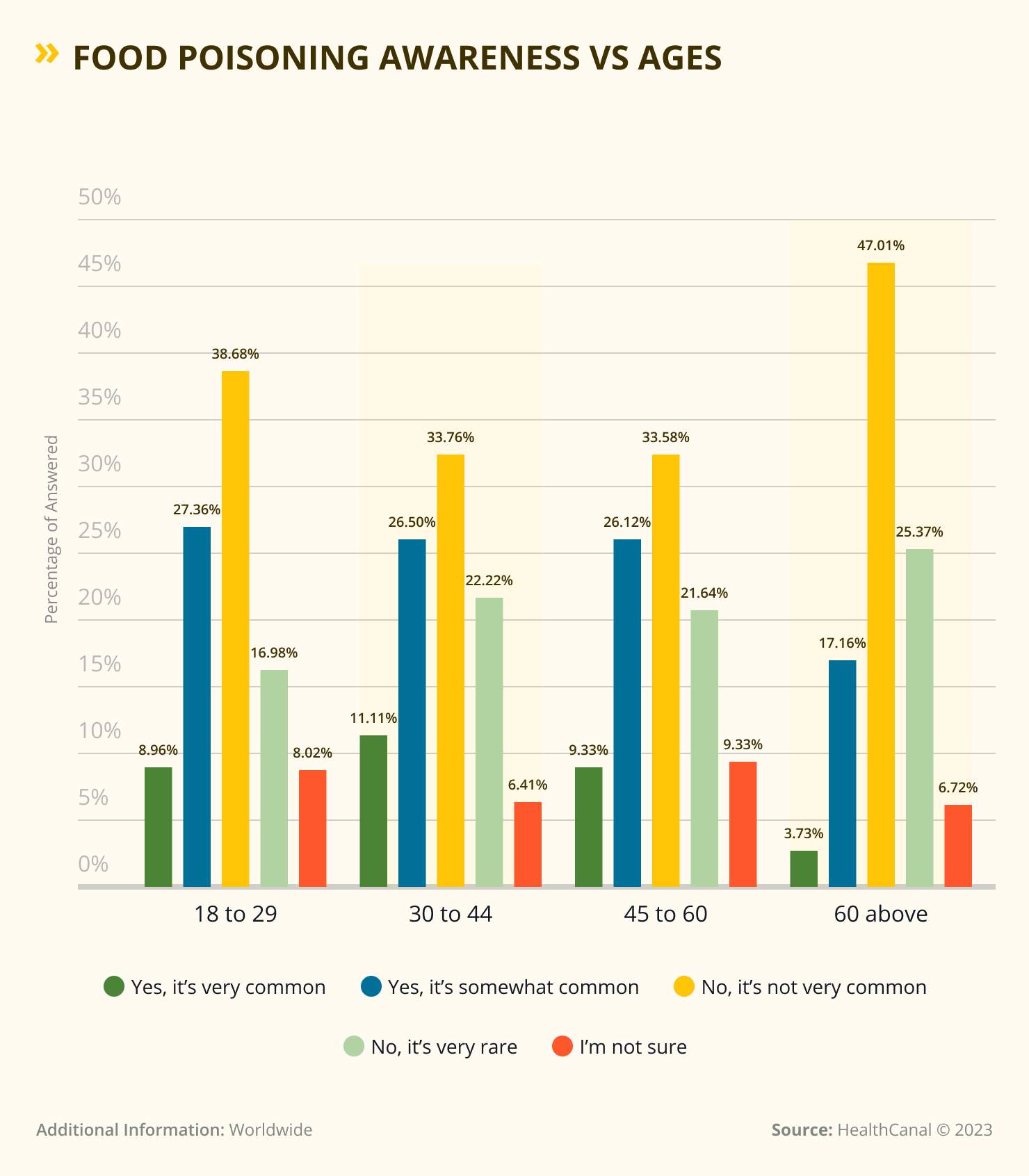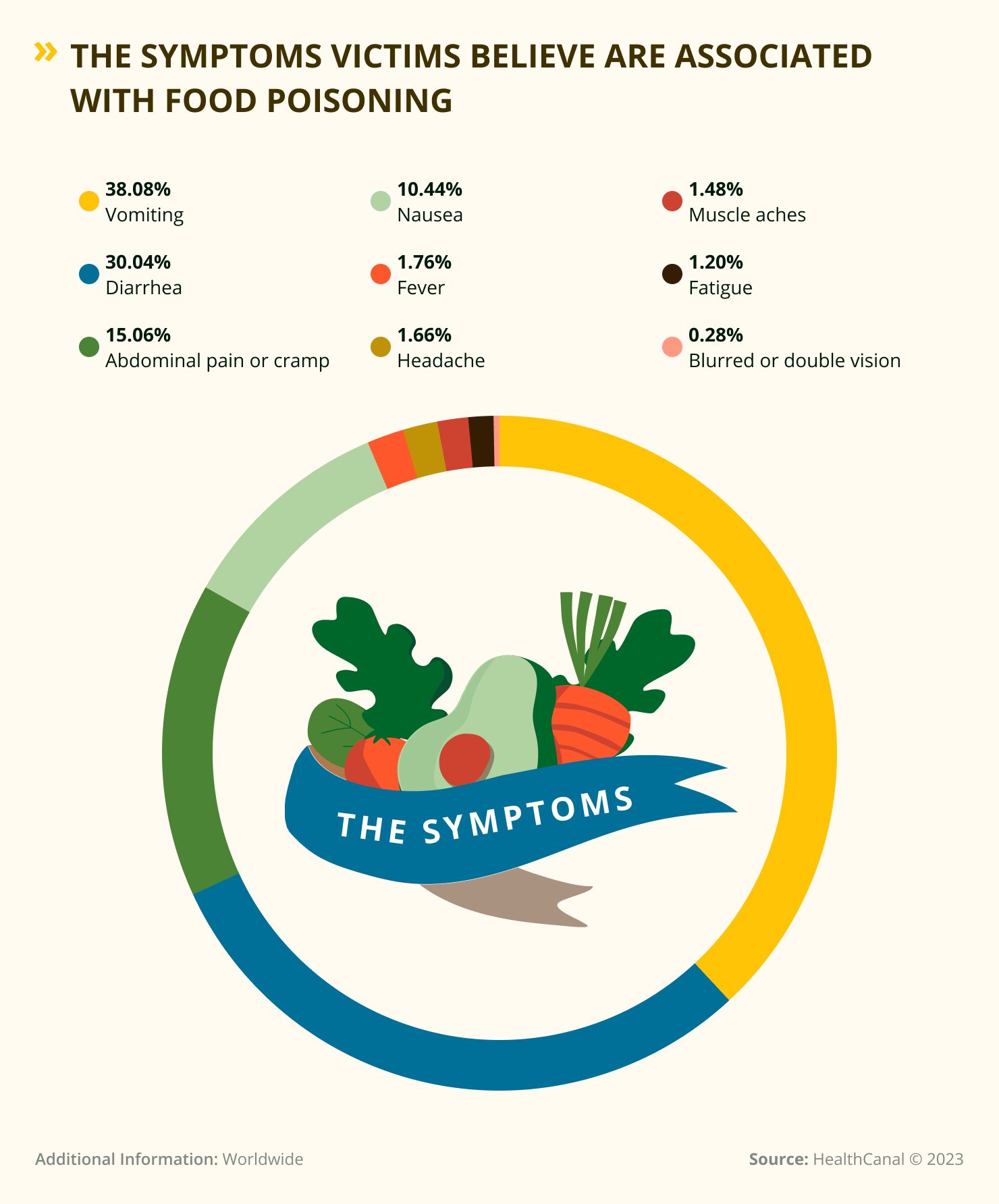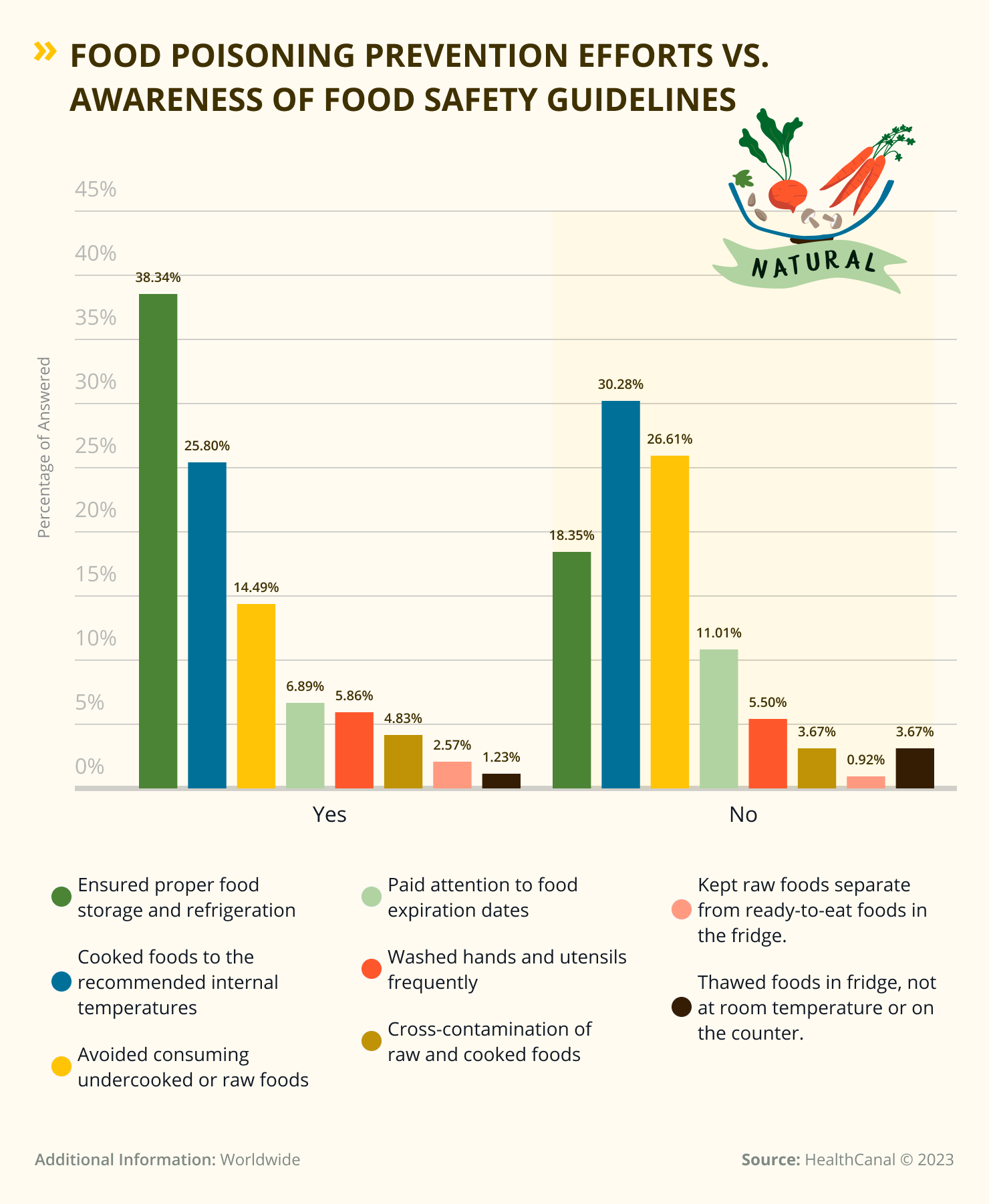Danger in the Kitchen: Foodborne Illness Awareness in the US
A recent survey has uncovered a concerning trend among US adults, suggesting a lack of serious attention towards food safety in home cooking environments.
Summary
A lackluster approach to food safety poses a risk of foodborne illnesses, turning an everyday necessity into a potential health hazard.
Each year, the U.S. sees approximately 48 million individuals fall ill due to foodborne diseases, according to the Centers for Disease Control and Prevention.[1] This staggering number includes around 128,000 hospital admissions and 3,000 annual fatalities.[1]
Health Canal’s collected data suggests an alarming two-thirds (66%) of U.S. adults may have personally suffered from food poisoning, illustrating the pervasive nature of this health concern.
Prioritizing food safety and understanding the risks of ignoring it is crucial in preventing food poisoning at home.
Study Methodology
Health Canal surveyed over 1,000 U.S. adults on September 25, 2023, utilizing an online survey platform. Data was collected continuously over 24 hours, facilitating real-time responses and reflections on food safety practices in home cooking environments.
Despite a sample size of 1,082 not being completely indicative of the broader U.S. population, respondents were dispersed throughout the country, thereby offering a broad-spectrum insight into the state of food poisoning experiences in residential kitchens.
Limitations of the survey may include potential self-reporting errors, social desirability bias, and the inherent digital divide that may exclude certain demographic groups. The latter suggests that the survey might have underrepresented groups with limited access to technology, such as lower-income or older individuals, which in turn may have influenced the overall results.
Key Findings
- The majority (66%) of people have experienced food poisoning first-hand.
- The most commonly cited probable cause of food poisoning was contamination from improper food handling or storage (35%).
- A significant 36% of respondents hold the misconception that food poisoning from home cooking is a very uncommon occurrence, a belief particularly prominent among older adults.
What Is Food Poisoning?
Food poisoning, or foodborne illness, is a common but preventable condition that arises when one ingests food or water contaminated with harmful bacteria, viruses, parasites, or toxins.
It often manifests as gastrointestinal distress, including symptoms like nausea, vomiting, diarrhea, abdominal pain, and sometimes fever.
Food poisoning symptoms typically begin within hours of eating contaminated food and can persist for a few hours to several days, depending on the type of pathogen involved.
Hussain Ahmad, MD, a consultant practitioner at Click2Pharmacy, not involved in the survey, explained to Health Canal, “Food poisoning can sometimes be a short period of sickness, but in extreme cases, you may need hospital treatment.”
However, symptoms of food poisoning may not always manifest immediately, making it difficult to determine the exact cause of the illness.
Causes Of Food Poisoning
A range of pathogens cause food poisoning in the U.S., but the primary cause of food poisoning in home cooking is contamination from harmful bacteria, such as Salmonella and Clostridium perfringens.[2]
Foodborne illnesses are often triggered by inadequate temperature control, particularly when improperly cooking, cooling, or reheating meat products, thereby enabling harmful organisms to survive and multiply.[2]
Factors like lack of time or resources, unsafe water and sanitation, cultural preferences in foods and culinary methods, and complacency also contribute to food poisoning incidents at home, says Alex Foxman, MD, FACP, medical director at Achieve Health and Weight Loss, not involved in the survey.
Common foods often associated with foodborne illness include meats, poultry, eggs, fish, sauces, milk and dairy products, produce, honey, and water. Additionally, rice, flour, soups, and puddings are frequently implicated in cases of food poisoning.
Harmful pathogens can penetrate our food supply at numerous phases, including farming, factory processing, or preparation and storage.
This emphasizes the need for rigorous food safety practices during home cooking and storage — the stage where consumers likely have the most control.
Are Home Kitchens Food Poisoning-Free?
Restaurants have been identified as key sites for foodborne disease outbreaks, with statistics revealing that they were responsible for approximately two-thirds of such incidents in 2017.[3]
However, according to a non-profit consumer advocacy group, the Center for Science in the Public Interest, the actual number of foodborne illnesses occurring in private homes is likely higher than reported.[4]
This is reflected in data from the CDC, which indicates an under-reporting of foodborne diseases, likely stemming from this knowledge gap and misplaced concerns about the source of safety risks.[5]
Edna Skopljak, MD, a medical advisor with Health Reporter, not involved in the survey, speaks to this point, suggesting, “Awareness is crucial as foodborne illnesses can take at least 6 hours to manifest, often misleading individuals about the source of contamination, leading to continued unsafe practices and unwarranted blame on restaurants.”
Among survey participants who have experienced food poisoning, when questioned about the suspected source of their foodborne illness, a significant number (35%) attributed their condition to possible food contamination due to incorrect handling or storage practices.
The second most prevalent explanation, by 23% of respondents, was the possible ingestion of undercooked food.
While conclusions can’t be drawn from this data alone, it does point to the importance of safe food handling practices at home, as a significant number (42%) of individuals reported they consume meals prepared in their own kitchen daily.
Dr. Skopljak agreed, explaining, “Based on [patients’] experiences, many individuals have encountered food poisoning, attributing it to various foods, both homemade and from restaurants. Misattribution is common, with people often blaming the last consumed meal, overlooking the actual contaminated source.”

Why Food Poisoning Occurs In Home Settings
Limited Awareness Of Home-Based Food Poisoning Risks
Despite the high prevalence of food poisoning incidents in the U.S., consumers’ awareness of food poisoning frequency remains limited.
In fact, more than a third (36%) of respondents believed that food poisoning is not very common, with another 22% perceiving it as a “very rare” occurrence.
This lack of awareness is likely due to several factors, including complacency, limited food safety education, and misconceptions about food poisoning.
Carlos Fragoso, MS, RD, owner and founder of Nutrethos, not involved in the survey, told Health Canal, “The number one reason I don’t think people adhere to basic food safety practices is because they don’t understand the urgency of it. For someone who has never experienced food poisoning, the prospect of it seems far-removed, but once you’ve experienced it you’ll never be careless of food safety again.”
Dr. Skopljak adds, “Individuals may not be aware that symptoms of food poisoning can vary widely, ranging from immediate discomfort and vomiting to symptoms appearing weeks later, depending on the contaminant.”

Age-Related Trends In Food Safety Complacency
Misunderstanding the risks associated with improper food handling, storage, and preparation can lead to an erroneous sense of immunity, thereby promoting complacency.
This false sense of security may be particularly prominent among older adults, possibly due to their accumulated years of cooking without encountering apparent issues.
Nearly half (47%) of respondents over 60 years old believed that food poisoning from home cooking was not very common.
Other age groups reported lower but still significant rates of not considering food poisoning a common occurrence, with 39% of respondents aged 18–29, 34% aged 30–44, and 34% aged 45–60 feeling similarly.
While older adults seemed to perceive food poisoning as less of a threat, they also didn’t identify with having experienced it as much as younger adults.
Those over age 60 reported the lowest prevalence of food poisoning, albeit still a significant proportion at 52%.
Larger portions of those aged 18–29 (67%), 30–44 (70%), and 45–60 (64%) reported having experienced food poisoning in the past.
It is unclear if this is due to actual lower occurrences of food poisoning in older adults or a lack of recognition or identification with the symptoms.
Still, these trends imply the need for more targeted food safety education and practices, as well as food poisoning symptom awareness, across all age groups.


Symptoms Of Food Poisoning May Go Unrecognized
Food poisoning can present a wide range of symptoms, some of which may not be immediately associated with food poisoning.
Following an incubation period of 1–36 hours (or longer) post-consumption, symptoms of cramping and abdominal pain usually appear, occasionally accompanied by diarrhea, nausea, and vomiting.[2] These discomforting symptoms typically persist for 1–3 days but may last longer depending on the pathogen and if complications develop.[6]
Survey respondents identified vomiting (38%), diarrhea (30%), abdominal pain or cramps (15%), and nausea (10%) as key symptoms associated with food poisoning.

Experts suggest that individuals should indeed look for these common symptoms, but it is also essential to recognize less apparent symptoms of foodborne illness:
“Uncommon or seemingly unrelated symptoms of food poisoning can be chronic fatigue, skin rashes/conditions, or even cold-like symptoms.”
Carlos Fragoso, MS, RD
“Apart from the usual upset stomach, you might also feel lightheaded, have muscle aches, or spike in temperature. Some people can even start vomiting or have bloody stools.”
Hussain Ahmad, MD
“Some symptoms that individuals may not be aware of are associated with food poisoning are difficulty in speaking or seeing, blood in urine, blurred vision, liver and kidney problems, and seizures. These symptoms may indicate a serious or life-threatening condition that requires immediate medical attention.”
Alex Foxman, MD, FACP
Symptoms may vary from person to person and can range from mild to severe depending on the type of pathogen causing the illness. Therefore, it is important to seek medical attention if symptoms persist or worsen.
How To Prevent Food Poisoning At Home
Although preventing food poisoning while dining out can be challenging, there are many ways to ensure food safety at home:
- Wash hands, utensils, and surfaces before and often during food preparation.
- Separate raw foods from cooked foods to avoid cross-contamination during preparation and storage.
- Use a food thermometer to ensure all meats are cooked to their recommended internal temperature to kill harmful bacteria.
- Refrigerate or freeze perishable foods promptly (within two hours of cooking).
- Avoid consuming raw or undercooked foods like meats, eggs, seafood, and unpasteurized products as they may contain harmful bacteria.
- Stay informed about any recalls of food products due to contamination. This information can be found via the FDA, the USDA, or local media outlets.
- Educate yourself on safe food handling techniques and follow reputable sources for information, such as government health agencies or accredited medical websites.

Of the people who had previously suffered from food poisoning, only 9% claimed to be unaware of the fundamental food safety procedures.
However, aside from these commonly known practices, other equally crucial methods may not be as widely known.
To raise awareness of additional food safety measures, experts suggested the following lesser-known strategies for preventing food poisoning at home:
“Avoid rinsing meat to prevent the spread of bacteria and contamination in the kitchen. Store and cook food properly, adhering to recommended temperatures. Be mindful of sell-by dates, considering the difference in storage temperatures between store and home refrigerators. Rely on trusted sources like the FDA and USDA for food safety advice and guidelines.”
Edna Skopljak, MD
“Check the expiration dates and labels of packaged foods before buying or eating them. Discard any food that looks or smells spoiled or has mold or insects on it. Wash fruits and vegetables thoroughly before serving them. Reheat leftovers thoroughly before eating them. Do not leave cooked food at room temperature for more than 2 hours.”
Alex Foxman, MD, FACP
“When storing raw ingredients in the refrigerator, raw poultry, fish, beef, pork, etc., should be stored on the lowest shelf — this is to prevent their juices from dripping on anything below them.”
Carlos Fragoso, MS, RD
The Takeaway
Individuals can significantly reduce home food poisoning risks by taking preventive measures more seriously.
This survey has identified a potential gap between food safety knowledge and practice in the homes of U.S. adults.
To address this, Dr. Skopljak emphasizes, “It is paramount to foster a culture of food safety awareness and education to mitigate the risks of foodborne illnesses. Relying on credible sources for information and maintaining vigilance in food handling can significantly reduce the incidence of food poisoning.”
Certain individuals, such as young children, older adults, pregnant women, and those with weakened immune systems, are more susceptible to severe foodborne illness.
“Food safety is everybody’s responsibility, and prevention is much better than cure. Practice food safety in the homes to keep your families safe from foodborne disease,” Dr. Foxman concludes.
Although food poisoning is typically mild and resolves without treatment, it’s important to take preventative measures to avoid life-threatening cases.
This is especially crucial when cooking at home, where you have the most control in ensuring the safety of yourself and those you care about.
Media Contact
Erik Pham
Founder of Health Canal
[email protected]
Author Note
Percentages may not sum to 100 due to rounding for easier reading and understanding.